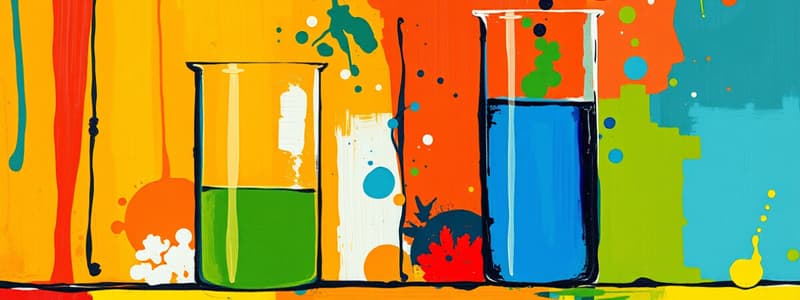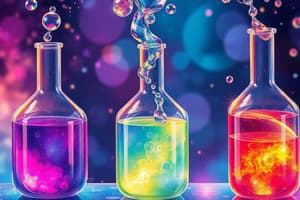Podcast
Questions and Answers
Define buffer capacity.
Define buffer capacity.
- Buffer capacity is the amount of acid that can be added until all of the acid is used up.
- Buffer capacity is the amount of acid or base that can be added to a buffer without destroying its effectiveness. (correct)
- Buffer capacity is the amount of base that can be added until all of the acid is used up.
- Buffer capacity is the amount of base that can be added until all of the base is used up.
- Buffer capacity is the amount of acid that can be added until all of the base is used up.
A solution containing equal molar amounts of which of the following pairs of substances will make a buffer solution?
A solution containing equal molar amounts of which of the following pairs of substances will make a buffer solution?
- CsF, HF
- None of these (correct)
- KBr, HBr
- NaI, HI
- RbCl, HCl
What change will be caused by the addition of a small amount of HCl to a solution containing fluoride ion and hydrogen fluoride?
What change will be caused by the addition of a small amount of HCl to a solution containing fluoride ion and hydrogen fluoride?
- The concentration of hydronium ion will increase significantly.
- The concentration of fluoride ion will increase as will the concentration of hydronium ion.
- The concentration of hydrogen fluoride will increase and the concentration of fluoride ion will decrease.
- The concentration of hydrogen fluoride will decrease and the concentration of fluoride ion will increase.
- The fluoride ion will precipitate out of solution as its acid salt. (correct)
Which of the following solutions has the greatest buffering capacity (can absorb the most acid or base with the least change in pH)?
Which of the following solutions has the greatest buffering capacity (can absorb the most acid or base with the least change in pH)?
Consider a solution prepared by mixing 0.43 mol of acetic acid with 0.28 mol of sodium acetate in 1.00 L of solution. The addition of 0.01 mol of HCl to this solution will cause the pH to _______ slightly because the HCl reacts with the _____ that is present.
Consider a solution prepared by mixing 0.43 mol of acetic acid with 0.28 mol of sodium acetate in 1.00 L of solution. The addition of 0.01 mol of HCl to this solution will cause the pH to _______ slightly because the HCl reacts with the _____ that is present.
Which of the following titrations is expected to have an equivalence point with a basic pH (pH>7)?
Which of the following titrations is expected to have an equivalence point with a basic pH (pH>7)?
Which of the following titrations is expected to have an equivalence point with a neutral pH (pH=7)?
Which of the following titrations is expected to have an equivalence point with a neutral pH (pH=7)?
A _____ yields a titration curve with an initial pH of 1.00, an equivalence point at pH 7.0, and a relatively long, nearly vertical middle section.
A _____ yields a titration curve with an initial pH of 1.00, an equivalence point at pH 7.0, and a relatively long, nearly vertical middle section.
An initial pH of 4.00, an equivalence point at pH 9.35 and a moderately short, nearly vertical middle section correspond to a titration curve for _____
An initial pH of 4.00, an equivalence point at pH 9.35 and a moderately short, nearly vertical middle section correspond to a titration curve for _____
An initial pH of 13.00, an equivalence point at 7.0, and a relatively long, nearly vertical middle section correspond to a titration curve for _____
An initial pH of 13.00, an equivalence point at 7.0, and a relatively long, nearly vertical middle section correspond to a titration curve for _____
In which of the following aqueous solutions would you expect AgCl to have the LOWEST solubility?
In which of the following aqueous solutions would you expect AgCl to have the LOWEST solubility?
Flashcards are hidden until you start studying
Study Notes
Buffer Capacity
- Buffer capacity measures the amount of acid or base added to a buffer without diminishing its effectiveness.
Buffer Solution Composition
- A buffer requires conjugate acid-base pairs in solution. None of the listed pairs (NaI/HI, KBr/HBr, RbCl/HCl, CsF/HF) create effective buffers.
Impact of Adding HCl
- Upon adding HCl to a mixture of fluoride ion and hydrogen fluoride, the fluoride ion precipitates out as its acid salt, affecting the equilibrium.
Buffering Capacity Comparison
- A mixture of 0.821 M HF and 0.909 M NaF exhibits the greatest buffering capacity due to closely matched molarity values.
Effect of HCl on Acetic Acid Solution
- Adding 0.01 mol of HCl to a solution of acetic acid and sodium acetate causes a slight decrease in pH as HCl reacts with the acetate ion.
Titration Equivalence Points
- A titration involving HC2H3O2 and KOH shows an equivalence point with a basic pH (pH > 7) since it involves a weak acid and strong base.
- Titrating HNO3 with NaOH results in a neutral pH (pH = 7) at the equivalence point as it involves a strong acid and a strong base.
Titration Curves
- A strong acid titrated by a strong base results in a titration curve with an initial pH of 1.00 and an equivalence point at pH 7.0.
- A weak acid titrated by a strong base yields an initial pH of 4.00 with an equivalence point at pH 9.35.
- A strong base titrated by a strong acid produces an initial pH of 13.00 and an equivalence point at pH 7.0.
Solubility of AgCl
- AgCl has the lowest solubility in a 0.020 M BaCl2 solution due to the common ion effect; presence of Cl⁻ ions decreases solubility.
- The question regarding the highest solubility of AgCl remains incomplete, but pure water typically enhances solubility compared to solutions with added salts.
Studying That Suits You
Use AI to generate personalized quizzes and flashcards to suit your learning preferences.




